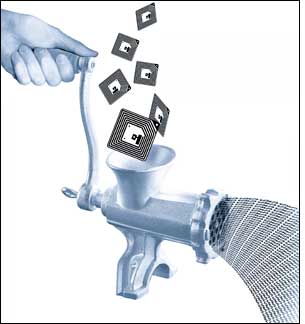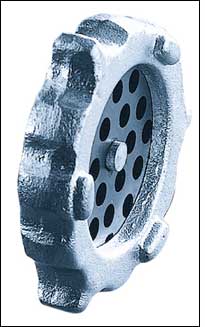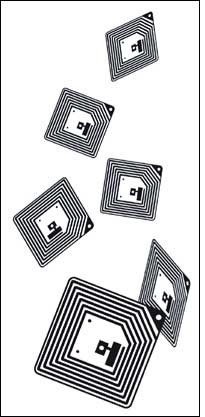Retailers and consumer packaged goods companies that have deployed radio frequency identification technology to track items through the supply chain in real time are improving inventory management, reducing out-of-stocks and boosting sales. That’s a significant return on investment. But there are more benefits in store for companies that take the next step and mine all that RFID data to address issues—such as ordering, merchandising and efficiencies—at the store, regional or corporate level.
RFID software that supports analytics functionality helps bring business intelligence to RFID deployments. The retail and CPG sector has gotten pretty good at understanding how RFID can address basic concerns such as inventory inaccuracy, out-of-stocks, loss and product mislocation, says Bill Hardgrave, executive director of the RFID Research Center at the University of Arkansas. “The part we’re really not good at is understanding what is causing that out-of-stock,” he says. “That’s all under that umbrella of data analytics and business intelligence.”

As companies get smarter about how they analyze historic data, they’ll be empowered to pinpoint weak spots and create predictive models on which to base proactive changes. For example, a retailer’s analysis of RFID data for a couple of sluggish sales weeks might reveal that a certain hot product was never taken out of the back room and displayed on the sales floor during that period. “You have to be aware, because awareness leads to solutions,” Hardgrave says. “That’s the beauty of this type of real-time system. It’s looking ahead, but to do that you have to be able to look back for an explanation first.”
Retailers that have closed-loop supply chains—controlling manufacturing, distribution and store activities—have been early adopters of RFID analytics software. “It gives them the ability to optimize their operations based on whether, for example, they see latency on products sitting in the distribution center longer than they should be, or they can track out-of-stocks back to an error being made in the way an ASN [advanced shipping notice] was being written so [products didn’t] reach the right place,” says Alan Sherman, director of marketing at OATSystems, which was recently purchased by Checkpoint Systems and offers the Merchandise Visibility analytics solution.
But retailers in open-loop supply chains can also benefit from analyzing RFID data to improve procurement and distribution to stores. For instance, retailers may find that stores in certain regions sell more apparel in a specific size, so they can integrate that intelligence into their distribution models. And CPG companies can perform trend analysis on transit times, inventory levels, lost sales due to supply-chain failures, and root causes for out-of-stocks by stock-keeping units, store and day.
In addition to Checkpoint, Seeonic, Retail Solutions, Sensormatic Retail Solutions/Vue Technology and Xterprise are among the leading vendors that offer software to help companies perform real-time and historic analytics on RFID data down to the item level. The vendors declined to give prices for their solutions, saying costs vary depending on factors such as modules deployed and hardware included.
“Software is a major capital expense, but we’re seeing more and more from companies that this is a great time to invest in software tools and analytics that will help us drive better store execution, create new business processes that squeeze out costs in the supply chain, or deliver better products at a cheaper price,” Hardgrave says. “They’re saying now is the time to do that, because years and years of research show that those companies that invest in IT in an economic downturn long term come out ahead of those companies that stopped investing.”
Benefits of Historic Data Analysis
It’s essential that any analysis of historic data be based on reliable information, and RFID provides an accurate real-time picture of the inventory in each store. “What a store [that doesn’t use RFID] has in inventory compared with what its systems think it has can be off by 35 percent,” says Timothy Von Kaenel, senior VP of business development and product management at Sensormatic Retail Solutions, which bought Vue Technology last fall. “Once you put real, 99.9 percent accurate information into your systems, you get efficiencies that go beyond the in-store benefits.”
The data warehousing and analytics layer is critical to making the most of RFID deployments, says John-Pierre Kamel, who leads the RFID practice at Excellis Consulting. “If you focus on turning the raw data you collect into actionable information, you will succeed in converting the theoretical opportunities in your business case into real-world benefits,” Kamel says. “This does not need to be complicated. Even rudimentary methods of pulling data out of systems with basic reporting or analytics tools will let you begin gaining value.”
Click here to view a larger version of the chart.
Here’s a closer look at some potential benefits:
Respond to shopper behavior. By deploying RFID to track the items shoppers take into the dressing room, retailers can reduce theft as well as mine the data to determine what clothing and accessories consumers typically try on together, leading to more effective in-store merchandising. “This is the tip of the iceberg on what we can do with this data,” says Jim Caudill, senior VP of marketing and strategy of Xterprise.
In fact, Hardgrave believes that over the next year improving the customer experience—with the appropriate privacy parameters in place—will be a primary focus of RFID-enabled business intelligence. Personal shoppers, for instance, could coordinate what customers bought last time they visited the store with companion items now on sale.
Analyze trial and purchase ratios. This is a big opportunity, according to Kamel. “If a pair of shoes is tried on a lot but your analysis of data finds that the closing rate is lower, that could indicate things like the style and look is attractive but the feel and fit isn’t,” he says. Such insight could help inform decisions about future orders of similar styles, and could drive product design for retailers that have closed-loop supply chains.
Similarly, retailers might learn that certain items tried on frequently in fitting rooms have a higher sell-through rate than others. “You can start to think store by store, and on a week-by-week basis, what’s happening and why,” says Venkat Krishnamurthy, Checkpoint’s head of research and development. “People think of analytics for planning next season’s inventory, but you can plan on a slightly more granular basis.”
Manage promotions more effectively. Some CPG companies and retailers are RFID-tracking promotional displays to ensure they make it onto the store floor during promotional periods, which can increase sales. With RFID analytics software, CPG companies can leverage the knowledge they capture from RFID-enabled stores to ensure future promotions with that retailer are optimized at every one of its locations—even stores that haven’t deployed the technology.
“A promotion will drive sales up even when the promotion may not be executed correctly,” says Cédric Guyot, Retail Solutions’ VP of marketing. A retailer can use the data from RFID-enabled stores to understand the sales lift when a promotion was carried out on time, and when it wasn’t. The insights gleaned from analyzing the sales lift distribution can be applied to non-RFID environments. “Our method extends RFID benefits to provide visibility in near- real time across all stores, whether they have an RFID reader infrastructure or not,” Guyot says.
Keep less stock, save more cash. In this economy, everyone wants to hold on to cash as long as possible. For retailers, that means deferring purchasing until the last moment, and for CPG companies, keeping on-hand inventory as low as possible. “Those who are successful use RFID to get views of what’s out there on the floor, on mannequins, on displays, what’s going on in the dressing rooms and at POS [point of sale], so they know what’s moving to make those rapid adjustments,” Xterprise’s Caudill says.
Excellis Consulting’s Kamel adds that suppliers that have access to RFID data from retail partners can make better production and logistics decisions, not only about what styles, colors and sizes to stock, but also in what quantities and at what priority levels. This allows them to avoid unnecessary production runs.
Shore up breakdowns. Just looking at the pattern of product movement—how many times the same item goes back and forth from the back room to the store floor, for instance—can reveal a lot about store execution and replenishment business processes, Hardgrave says. RFID data gives retailers the granular information they need to explore why certain unusual patterns exist, so they can takes steps to improve them. “Once you can start asking why and you can start finding the answer,” he says, “you can see serious process execution breakdowns a retailer didn’t know it had.”
Analyze Your Options
RFID analytics software is most helpful when a business approaches its deployment with some idea of the questions it wants to have answered, rather than just collecting hundreds of terabytes of miscellaneous data. If you log and store every single RFID read, you can log crazy amounts of information,” Kamel says. “The question is what to capture, what you need.”
Most RFID analytics software includes data management capabilities and applications for real-time and historic trending analysis, with customizable reporting tools and operational dashboards. In some cases, vendors provide mainly baseline functions around aggregated data for corporate analytics, and users tailor the analytics frameworks to their specific requirements. The products generally can be packaged with a variety of modules, so companies must investigate their options carefully to see which tools best suit their needs.
In addition, the RFID data can be integrated with a company’s back-end systems so it feeds into manufacturing and replenishment decision-making. But many legacy systems don’t understand the item-level information RFID provides. Integrating RFID data with, say, an enterprise resource planning or POS system can be complex and costly, and may require the services of a systems integrator or consultant.
The products are available as hosted solutions or as software deployed on site, in some cases within a hardware appliance. Checkpoint, for example, employs a small controller box to which it can dynamically provision software. “We don’t just plunk a server in a store that loads software and runs data through it—that doesn’t work to scale to hundreds of stores,” says Krishnamurthy. “You can’t have hundreds of servers, because your ROI will be out of whack.”
Retail Solutions offers a software-as-a-service (SaaS) model, to address both scalability questions around internal infrastructure and the current economic environment. Guyot says its pay-as-you-go SaaS model is attractive to companies that are hesitant to make big IT investments right now. The vendor also offers an on-site appliance-based solution.
For companies that haven’t deployed RFID at the item level, or that want to expand their deployments and need additional infrastructure, Sensormatic Retail Solutions offers a complete system—hardware, software and services. That fits into the retail channel’s modus operandi; the sector hasn’t traditionally been a leader when it comes to IT, but has a history of buying turnkey IT solutions.
All these RFID analytics products support the Electronic Product Code Information Services (EPCIS) standard, which enables retailers to share EPC RFID data with their partners securely over the Internet. This is essential, because today most data is shared from point to point, often by different means and sometimes in different formats. That makes it difficult for CPG suppliers to aggregate the data and assess demand for its products across the different retail chains they service. EPCIS provides a more consistent and efficient way to communicate.
Experts advise that even retailers operating closed-loop environments should consider this approach. “Why not go ahead and adopt the standards that are out there, and if you need to open up your closed loop, then you are ready to do that,” Hardgrave says. Companies that delay will have to dedicate time and money to that effort down the road, when the business case may be tougher to make.
RFID analytics solutions give retailers real-time visibility into the true inventory position of each store, says Excellis Consulting’s Kamel. If this information is mined and used correctly, retailers can restock and replenish products more effectively, ultimately reducing out-of-stocks and boosting revenue.





